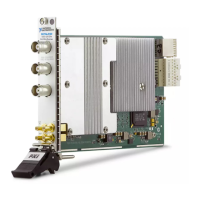PXIe-5160/5162 Self-Calibration
To eliminate errors caused by changing temperatures, NI-SCOPE provides a highly repeatable
self-calibration function.
For the PXIe-5160/5162, self-calibration yields the following benefits:
• Corrects for DC gain and offset errors within the digitizer by comparison to a precision,
high-stability internal voltage reference for all ranges, input impedance paths (50 Ω and
1 MΩ), and filter paths.
• Calibrates trigger level offset and gain.
• Calibrates trigger timing, as well as the time-to-digital conversion circuitry to ensure
accurate trigger timing and time-stamping.
• Calibrates gain, offset, and phase for interleaved ADC modes, reducing ADC interleaving
errors in time-interleaved sampling modes.
• Calibrates the phase DAC used to adjust the phase of the sample clock.
Self-calibration takes approximately two minutes to complete.
Running Self-Calibration
Running self-calibration enables the PXIe-5160/5162 to yield full performance over its
operating temperature range and two-year external calibration cycle.
Before running self-calibration:
• Warm up the PXIe-5160/5162 for at least 15 minutes
• When possible, disconnect the inputs
1
PXIe-5160/5162 modules are externally calibrated at the factory, but for optimal performance,
use self-calibration in any of the following situations:
• When the module is placed in a new system
• When the temperature changes more than ±3 °C from the previous self-calibration
• Once 90 days have elapsed since the previous self-calibration
Note Unless temperature variations are a serious problem in your application, self-
calibration is not recommended more than once per day.
Tip You can use the nodes on the NI-SCOPE External Calibration palette to
programmatically return the date and module temperature of the previous self-
calibration. You can also view this information by selecting the device in MAX.
Self-calibrate the PXIe-5160/5162 programmatically in NI-SCOPE or on demand in MAX.
Option Description

